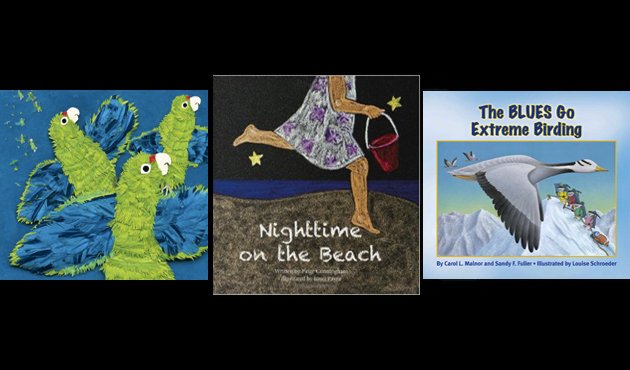
I love reading children’s books, even though my child is well over the age when she asks to have them read at bedtime and my nephews fall asleep all too easily after playing lacrosse all day. I enjoy collecting children’s books about birds and nature that I come across in the expected (book stores) and unexpected (academic library conference reports) places. Here are three excellent but very different children’s books I enjoyed this year (two were published in 2013, one in 2011). Let me know your recommendations for books kids would enjoy reading, or having read to them, this summer.
Deep cobalt blue wings, dreamy turquoise skies, hints of scarlet red over white curves, the browns, yellows, and pinks of people within gray-green-darker-green rain forests. Parrots Over Puerto Rico is a wonderland of colors and shapes. It is a book that is a joy to view and surprisingly enriching to read. The story of the Puerto Rican Amazon, also known as the Puerto Rico Parrot, Parrots Over Puerto Rico is illustrated with deeply hued collages created by Susan L. Roth; the informative, graceful text is by Susan L. Roth and Cindy Trumbore. The book is read vertically, each page lifted up, which allows the collages to take up two-thirds of each two-page spread, drawing the reader (or pre-reader) into the parrots’ world. And, a wonderful world it was.
Iguaca! Iguaca! The parrots called as they looked for deep nesting holes in the tall trees.
Down below, waves from the Caribbean Sea and the Atlantic Ocean washed the island’s white-sand beaches.
There are two stories here–the story of the parrots, and the story of the settlement of the island of Boriquén, which became the island of Puerto Rico. First there were the parrots, then the Taínos, who arrived around 800 CE. The Taínos named the birds Iguacas, after their call. Spanish settlers arrived in 1493 and called the birds Coterras. Other Europeans came. Africans were brought over as slaves. They cut down the trees the parrots used for nesting and brought black rats, who ate their eggs, and honeybees who swarmed into their nests, and by 1937 there were only about 2,000 Puerto Rican Parrots left. In a few years they could only be found in El Yunque, a tropical rain forest in northeast Puerto Rico. Meanwhile, forts were built to protect the island from invaders, war broke out between Spain and the United States, and the island became a U.S. territory. And, the parrots almost, but not quite, disappear from the face of the earth.
This is a surprising amount of story for what looks like a picture book. It really isn’t. The targeted age group is 6 to 11 years. Instructional features, such as notes on the pronunciation of words like Iguaca (ih-GWAH-kah) and a fact-filled Afterward, create a platform for using Parrots Over Puerto Rico in home-study or classroom settings. But, you never get the feeling that you are reading an EDUCATIONAL book. The rich illustrations give a fable-like texture to the parrots’ story, enhancing aspects that are not always pretty or dramatic.
We see the parrots’ disappearance visually as their images get smaller and scarcer in each collage illustration. In 1967 only 24 parrots were living in El Yunque. This is illustrated by the image of a stunning waterfall. In the lower right-hand corner we see the partial figure of a bespectacled hiker. At the top of the page we see only the feet and bottoms of two parrots as they fly away. For a minute we think we see other parrots, but closer examination reveals they are other stuff of the rain forest, maybe lizards, maybe leaves, visual ghosts of parrots long gone.
This plate is right at the center of the book. The second half of the story describes the many-faceted initiatives of the Puerto Rican Parrot Recovery Program. Success is not easily achieved. An aviary is created to keep the parrots safe from predators. Still, by 1975, “only thirteen parrots were left in the rain forest.” Special nesting boxes are built in the wild, a wild chick damages its wing in the nest, (it is rebuilt). Hurricane Hugo rips through the island in 1989. A second aviary is created. Captive-bred parrots are released into the wild and eaten by hawks. (Roth depicts a brown, tail-banded, evil-eyed hawk with an open-eyed parrot held upside-down, wings spread, in its claws). A hawk-avoidance training program is created. A second flock is released into the wild in 2006. The birds thrive. We see a Puerto Rican Parrot flying over the heads of two humans (the authors, it turns out), their yellow and white shirts shining like beacons in a landscape of forest and olive and emerald greens and cobalt blues. And, we know, from the images imprinted on our brains, that the blues are the wings of more parrots, still flying over Puerto Rico. This is a story with a happy, hopeful ending.
Several features emphasize the book’s educational side. As I noted above, Spanish words and names are transliterated so readers will know the proper pronunciation (El Yunque–ell YOON-keh). An Afterword describes the work of the Puerto Rican Parrot Recovery Program in factual detail, accompanied by photos of project workers and the parrots. There is also a chronology, “Important Dates in the History of Puerto Rico and Puerto Rican Parrots” and “Authors’ Sources,” books and articles about the parrots and Puerto Rico. These features are unobtrusive enough that the book can be read without the educational add-ons, but informative enough to provide easily accessible background to the child who wants to know more. In addition, a separate 11-page Teacher’s Guide can be downloaded from the publishers website.
This is the second nonfiction book by Susan L. Roth and Cindy Trumbore. The first, The Mangrove Tree: Planting Trees to Feed Families, tells the story of Dr. Gordon Sato’s mangrove tree-planting project, which transformed the African village of Hargigo. Both are talented children’s book creators whose titles have won many awards. (Parrots Over Puerto Rico has so far won the American Library Association’s Robert F. Sibert Informational Book Medal, which is how I heard about it, and the Américas Book Award for Children’s & Young Adult Literature.) They are published by Lee & Low Books, an independent children’s book publisher that specializes in books on multicultural topics by people of diverse backgrounds. Once you read Parrots Over Puerto Rico, look up the interview with Roth and Trumbore on the Lee & Low website, Soaring Behind the Scenes of Parrots Over Puerto Rico. I think you’ll be surprised to find out how Cindy Trumbore got the idea for this book. (Clue: El Yunque is featured on one of the coins in the America the Beautiful Quarters program.)
As you can tell, I fell in love with the collages of Parrots Over Puerto Rico. This is a story that offers a lot to children, specifically as a story of parrots in Puerto Rico and more generally as an introduction to the concept that human activity affects the world around us and that dedicated men and women can in turn create positive change. And, of course, it shows the beauty of the world of the rain forest.
If it is a lively picture book about nature that you are looking for, I highly recommend Nighttime on the Beach, written by Paige Cunningham and illustrated by Janet Payne. The story is simple and lyrical–three friends take a night walk on the beach, looking for ghost crabs. The walk is told from the children’s perspective, in quick, Seuss-like rhymes:
We look we smile,
we wave hello.
Is it friend?
Or is it foe?
The illustrations also take on a child’s eye view — close-ups of legs and hands and crabs in grainy browns and reds, textured tans and greens, yellow stars against a subtly sparkly black sky, crab claws almost indistinct in the dark till a flashlight shines on its pale body.
It looks like the illustrations were created with colored chalk on sandpaper, a terrific idea that didn’t occur to me till I noticed that the authors thank a woodworking shop in North Carolina for “quality sandpaper for the illustrations”. I wish they had provided more information about this aspect of the book’s creation. I really like to know the story behind the book.
Paige Cunningham and Janet Payne both live in the Cape May, New Jersey area and previously collaborated on a book about Cape May A to Z. The story in Nighttime on the Beach is based on Cunningham’s ghost crab walks on the beaches of Cape May, which she has been leading for over 10 years. The last two pages of the book offer tips for Ghost Crab Viewing and additional facts about these elusive creatures. This is a great book to read to young children going to the beach for the summer; even if they don’t go for a night walk, it will encourage them to look for other beach creatures during the day.
Finally, for birders who want to instill a knowledge of birds into their children from an early age, there are The Blues Go Birding books. This series by Carol L. Mainor and Sandy F. Fuller, with illustrations by Louise Schroeder, is in the Magic School Bus tradition. Only, instead of a group of children going on scientific adventures with their teacher, a band of five young bluebirds go on bird watching adventures on their own. Like the Magic School Bus books, information in the main text is supplemented by facts detailed on the side of the page, excerpts from the Blues’ field notes.
For this review, I took a look at The BLUES Go Extreme Birding, the third book in the series. In this case, “extreme birding” does not mean accumulating the longest day list. The Blues (Bing, Lulu, Uno, Eggbert, and Sammi) go looking for birds that set records, that are the best in what they do. They start out in New York City, climbing a skyscraper to see a Peregrine Falcon, the world’s fastest-moving bird, diving at almost 200 miles an hour after a pigeon. Eggbert side notes that the most famous bird in New York City is not a falcon, it is a Red-tailed Hawk named Pale Male. The Peregrine’s image is huge and impressive, like an avian rocket.
The Blues visit 11 more birds around the world (they are very sophisticated bluebirds), from an Arctic Tern in Alaska (migrates the longest distance) to a Horned Sungem Hummingbird in Brazil (fastest wingbeat). My favorite was the Greater Flamingo in Tanzania (Pinkest bird!). Each two-page spread shows a realistic illustration of the target bird (or birds, in the case of a brief stop in the Brazilian rain forest–greatest variety of birds) in its habitat counterpointed with the cartoon-like baby bluebirds, who wear binoculars and cameras around their necks and travel in kayaks and planes. The authors note that while the baby bluebirds are intentionally portrayed as caricatures, the subject birds are carefully researched. The last page offers online resources for finding out more about birds, getting feeders to create a backyard bird environment, and nature activities with children.
The text, which largely consists of conversations amongst the five Blues, carries the story forward; quips in dialog balloons add humor; and the field guide and notebook pages on the side of the page give us additional facts about the bird and other record-setters. If you are experienced at reading this type of book, then you know that you can read part or all of each page, depending on the interest and skills level of your child. Or, they can read it themselves. Or, you can read it. The recommended age level is 5 years and up, and I am going to assume that this means adults as well. It’s hard to resist a book that ends with the conclusion that the best extreme sport is Extreme Birding, and that “all birds are champions and bird watching the best sport.”
It truly is, and there’s only one thing better than passing this on to children through books. Take a child (any child!) birding this summer. And, then relive your adventure by reading a book.
—————————————–
Parrots Over Puerto Rico
by Susan L. Roth and Cindy Trumbore, collages by Susan L. Roth.
Lee & Low Books, October 2013.
Hardcover, 48 pages; 10.4 x 9 x 0.3 inches.
ISBN-10: 1620140047, ISBN-13: 978-1620140048.
$19.95
Nighttime on the Beach
by Paige Cunningham (author) and Janet Payne (illustrator)
SeaGrove Press, July 2013.
Paperback, 32 pages; 8.4 x 8.4 x 0.2 inches.
ISBN-10: 0989560902, ISBN-13: 978-0989560900
$9.75
The BLUES Go Extreme Birding
by Carol L. Mainor and Sandy F. Fuller, illustrated by Louise Schroeder
Dawn Publications, March 2011.
paperback, 36 pages, 9.3 x 10.3 x 0.2 inches, $8.95
ISBN-10: 1584691344, ISBN-13: 978-1584691341
hardcover, 36 pages, 10.4 x 9.4 x 0.5 inches, $15.25
ISBN-10: 1584691336, ISBN-13: 978-1584691334


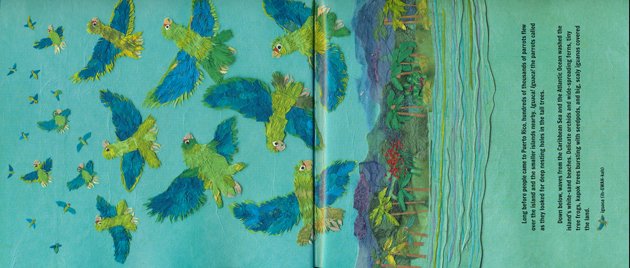
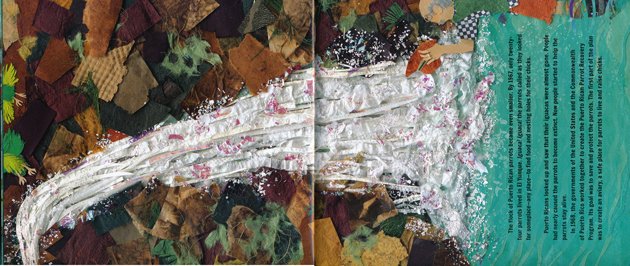
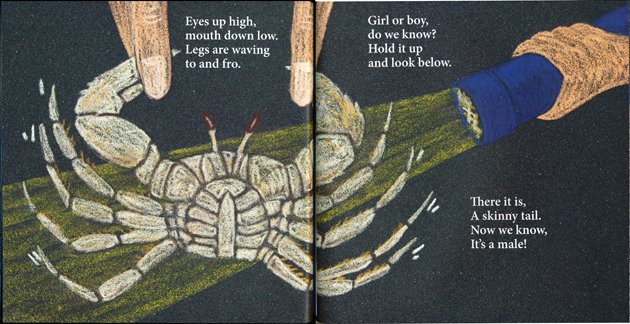
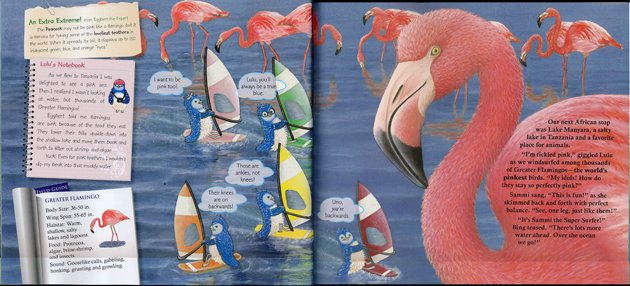











Leave a Comment